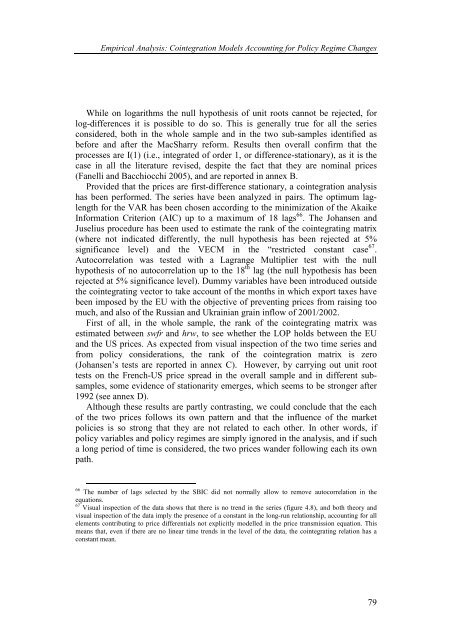TESTING INTERNATIONAL PRICE TRANSMISSION UNDER ...
TESTING INTERNATIONAL PRICE TRANSMISSION UNDER ...
TESTING INTERNATIONAL PRICE TRANSMISSION UNDER ...
Create successful ePaper yourself
Turn your PDF publications into a flip-book with our unique Google optimized e-Paper software.
Empirical Analysis: Cointegration Models Accounting for Policy Regime Changes<br />
While on logarithms the null hypothesis of unit roots cannot be rejected, for<br />
log-differences it is possible to do so. This is generally true for all the series<br />
considered, both in the whole sample and in the two sub-samples identified as<br />
before and after the MacSharry reform. Results then overall confirm that the<br />
processes are I(1) (i.e., integrated of order 1, or difference-stationary), as it is the<br />
case in all the literature revised, despite the fact that they are nominal prices<br />
(Fanelli and Bacchiocchi 2005), and are reported in annex B.<br />
Provided that the prices are first-difference stationary, a cointegration analysis<br />
has been performed. The series have been analyzed in pairs. The optimum laglength<br />
for the VAR has been chosen according to the minimization of the Akaike<br />
Information Criterion (AIC) up to a maximum of 18 lags 66 . The Johansen and<br />
Juselius procedure has been used to estimate the rank of the cointegrating matrix<br />
(where not indicated differently, the null hypothesis has been rejected at 5%<br />
significance level) and the VECM in the “restricted constant case 67 .<br />
Autocorrelation was tested with a Lagrange Multiplier test with the null<br />
hypothesis of no autocorrelation up to the 18 th lag (the null hypothesis has been<br />
rejected at 5% significance level). Dummy variables have been introduced outside<br />
the cointegrating vector to take account of the months in which export taxes have<br />
been imposed by the EU with the objective of preventing prices from raising too<br />
much, and also of the Russian and Ukrainian grain inflow of 2001/2002.<br />
First of all, in the whole sample, the rank of the cointegrating matrix was<br />
estimated between swfr and hrw, to see whether the LOP holds between the EU<br />
and the US prices. As expected from visual inspection of the two time series and<br />
from policy considerations, the rank of the cointegration matrix is zero<br />
(Johansen’s tests are reported in annex C). However, by carrying out unit root<br />
tests on the French-US price spread in the overall sample and in different subsamples,<br />
some evidence of stationarity emerges, which seems to be stronger after<br />
1992 (see annex D).<br />
Although these results are partly contrasting, we could conclude that the each<br />
of the two prices follows its own pattern and that the influence of the market<br />
policies is so strong that they are not related to each other. In other words, if<br />
policy variables and policy regimes are simply ignored in the analysis, and if such<br />
a long period of time is considered, the two prices wander following each its own<br />
path.<br />
66<br />
The number of lags selected by the SBIC did not normally allow to remove autocorrelation in the<br />
equations.<br />
67<br />
Visual inspection of the data shows that there is no trend in the series (figure 4.8), and both theory and<br />
visual inspection of the data imply the presence of a constant in the long-run relationship, accounting for all<br />
elements contributing to price differentials not explicitly modelled in the price transmission equation. This<br />
means that, even if there are no linear time trends in the level of the data, the cointegrating relation has a<br />
constant mean.<br />
79
















